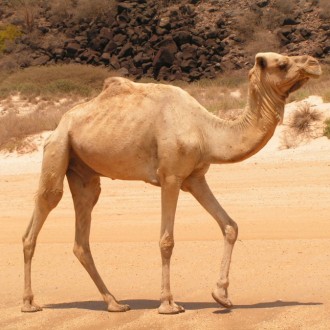


How to Draw a Camel
Please PAUSE the video after each step to draw at your own pace.
For the first few steps, don’t press down too hard with your pencil. Use light, smooth strokes to begin.
Step 1: Draw two circles as guides for the camel’s body. The circles don’t have to be perfect. They’re just guides. The circle on the left should be a bit smaller than the circle on the right. Don’t place the circles too far apart or the camel will end up too long.
Step 2: Draw a smaller circle on the upper right side as a guide for the camel’s head. Camels have long necks, so don’t place the head too close to the body.
Step 3: Draw a U-shaped arc on the right side of the head as a guide for the muzzle.
Step 4: Draw a series of curved lines tha tconnect the major shapes to form the neck and body. The line for the top of the body should bulge up more for the hump. The taller the curve on the line, the bigger the hump will be.
Step 5: Draw four lines under the body (two below each circle) as guides for the legs. Camels also have long legs, so draw long lines. Also bend the lines a bit near the middle.
That’s it for the initial sketch! From this point on, press harder with your pencil to get a more defined sketch.
Step 6: Draw the eye inside the head on the upper right side. The shape of the eye is similar to a football. Shade the inside of the eye to create the eyeball and pupil. Leave a tiny circle unshaded for glare. Camels have long eyelashes to protect their eyes from sand, so draw bushy lines around the eye. Draw a few more lines around the eye for wrinkles and extra detail.
Step 7: Draw the nose on the tip of the initial arc guide. First draw the outer structure of the nose using a few curved lines. Then draw the nostril as a small slit within the shape.
Step 8: Draw the mouth using the initial arc as a guide. Draw the thick upper lip first and the mouth that stretches to the left. Then draw the samller lower lip at the bottom.
Step 9: Draw a small arc on the upper left side of the head for the camel’s ear. Draw some quick, short strokes at the base of the ear for the hair inside the ear.
Step 10: Use the remaining lines and shapes as guides to draw the rest of the camel’s head. Darken the top and bottom lines and draw a curved line on the lower left side for the jaw line. Draw a few quick, short strokes throughout the head to represent fur and a few lines on the neck for folds of skin.
Step 11: Using the lines as guides, draw the camel’s front legs. Follow the basic path of the guide line as you thicken up the leg. Draw it lightly at first to get the structure right. When you’re happy with what you have, go ahead and darken it. As you darken the leg, give it an extra bump in the middle for the joint and make the top or base wider. Draw the wide feet with two toes at the bottom. Draw a nail at the end of each toe using curved lines. Draw the front leg on the other side the same way. Draw lightly at first to get the structure right as you follow the basic path of the guide line. Don’t forget the two toes at the bottom!
Step 12: Now use the other lines as guides to draw the hind legs. The base of the hind legs is thicker, and it extends farther into the body. Remember to sketch lightly at first and only darken the lines once you get the structure right. The hind legs bend back more at the joint than the front legs. The feet are wide at the bottom. Draw a few lines at the joint for wrinkles. Draw the hind leg on the other side using the same technique. Unlike many other animals, camels move both legs on one side of the body at the same time. So draw the legs accordingly.
Step 13: Draw the rest of the camel’s body by using the remaining lines as guides. Darken the guide lines as you follow their basic path. Draw a few extra lines throughout the body for the folds of skin and patches of longer fur. Use quick, short strokes at the top of the hump as you darken it to represent the fur on top of it. Draw the tail on the left side next to the leg using quick, short strokes.
Step 14 (optional): You can stop here for a sketchy look or erase as much as you can of the initial guide lines for a cleaner look. Don’t worry about erasing all of them. It’s okay to leave some behind. Also re-draw any final sketch lines that you may have accidentally erased.
Step 15 (optional): Add some shading to your drawing to give it more dimension and volume. Pick the direction of the light source when shading so that the shadows are consistent with it. Vary the pressure on your pencil to get different degrees of tonal value.
Step 16 (optional): Add a cast shadow underneath. This helps ground the camel so it doesn’t appear to be floating.
Step 17 (optional): You can add more value throughout your camel drawing for extra detail. It’s always a good idea to use reference for accuracy, and remember to PAUSE the video any time you need help.


